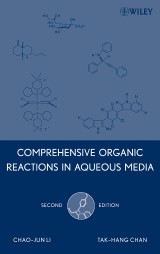Details

Comprehensive Organic Reactions in Aqueous Media
2. Aufl.
|
168,99 € |
|
| Verlag: | Wiley |
| Format: | |
| Veröffentl.: | 04.06.2007 |
| ISBN/EAN: | 9780470131435 |
| Sprache: | englisch |
| Anzahl Seiten: | 448 |
DRM-geschütztes eBook, Sie benötigen z.B. Adobe Digital Editions und eine Adobe ID zum Lesen.
Beschreibungen
An extensive update of the classic reference on organic reactions in water<br /> <br /> Published almost a decade ago, the first edition has served as the guide for research in this burgeoning field. Due to the cost, safety, efficiency, and environmental friendliness of water as a solvent, there are many new applications in industry and academic laboratories. More than forty percent of this extensively updated second edition covers new reactions. For ease of reference, it is organized by functional groups. A core reference, Comprehensive Organic Reactions in Aqueous Media, Second Edition:<br /> <br /> * Provides the most comprehensive coverage of aqueous organicreactions available<br /> * Covers the basic principles and theory and progresses to applications<br /> * Includes alkanes, alkenes, aromatics, electrophilic substitutions, carbonyls, alpha, beta-unsaturated carbonyls, carbon-nitrogen bonds, organic halides, pericyclic reactions, photochemical reactions, click chemistry, and multi-step syntheses?<br /> * Provides examples of applications in industry<br /> <br /> This is the premier reference for chemists and chemical engineers in industry or research, as well as for students in advanced-level courses.
<b>PREFACE TO THE SECOND EDITION.</b> <p><b>1. INTRODUCTION.</b></p> <p>1.1 The Structure and Forms of Water.</p> <p>1.2 Properties of Water.</p> <p>1.3 Solvation.</p> <p>1.4 Hydrophobic Effect.</p> <p>1.5 Salt Effect.</p> <p>1.6 Water Under Extreme Conditions.</p> <p>References. </p> <p><b>2. ALKANES.</b></p> <p>2.1 Oxygenation of Alkanes.</p> <p>2.2 Halogenation of Alkanes.</p> <p>2.3 Formation of Carbon–Carbon Bonds.</p> <p>2.4 D/H Exchange of Alkanes in Water.</p> <p>References. </p> <p><b>3. ALKENES.</b></p> <p>3.1 Reduction.</p> <p>3.2 Electrophilic Additions.</p> <p>3.3 Radical Reactions of Alkenes.</p> <p>3.4 Carbene Reactions.</p> <p>3.5 Alkene Isomerization.</p> <p>3.6 Transition-Metal Catalyzed C–C Formation Reactions.</p> <p>3.7 Olefin Metathesis.</p> <p>3.8 Reaction of Allylic C–H Bond.</p> <p><b>4. ALKYNES.</b></p> <p>4.1 Reaction of Terminal Alkynes.</p> <p>4.2 Additions of C≡C bonds.</p> <p>4.3 Transition-Metal Catalyzed Cycloadditions.</p> <p>4.4 Other Reactions.</p> <p>References. </p> <p><b>5. ALCOHOLS, PHENOLS, ETHERS, THIOLS, AND THIOETHERS.</b></p> <p>5.1 Oxidation of Alcohols.</p> <p>5.2 Substitutions/Elimination.</p> <p>5.3 Addition of Alcohols, Phenols, and Thiols to Alkene and Alkyne Bonds.</p> <p>5.4 Addition of Alcohols to C=O Bonds: Esterification and Acetal Formations.</p> <p>5.5 Reaction of Ethers and Cyclic Ethers.</p> <p>5.6 Reaction of Sulfur Compounds.</p> <p><b>6. ORGANIC HALIDES.</b></p> <p>6.1 General.</p> <p>6.2 Reduction.</p> <p>6.3 Elimination Reactions.</p> <p>6.4 Nucleophilic Substitutions.</p> <p>6.5 Reductive Coupling.</p> <p>6.6 Carbonylation of Organic Halides.</p> <p>6.7 Transition-Metal Catalyzed Coupling Reactions.</p> <p>References. </p> <p><b>7. AROMATIC COMPOUNDS.</b></p> <p>7.1 General.</p> <p>7.2 Substitution Reactions.</p> <p>7.3 Oxidation Reactions.</p> <p>7.4 Reductions.</p> <p>References. </p> <p><b>8. ALDEHDYE AND KETONES.</b></p> <p>8.1 Reduction.</p> <p>8.2 Oxidation.</p> <p>8.3 Nucleophilic Addition: C–C Bond Formation.</p> <p>8.4 Pinacol Coupling.</p> <p>8.5 Other Reactions (Halogenation and Oxidation of α-H).</p> <p>References. </p> <p><b>9. CARBOXYLIC ACIDS AND DERIVATIVES.</b></p> <p>9.1 General.</p> <p>9.2 Carboxylic Acids.</p> <p>9.3 Carboxylic Acid Derivatives.</p> <p>References. </p> <p><b>10. CONJUGATED CARBONYL COMPOUNDS.</b></p> <p>10.1 Reduction.</p> <p>10.2 Epoxidation, Dihydroxylation, Hydroxyamination.</p> <p>10.3 Conjugate Addition: Heteroatom.</p> <p>10.4 C–C Bond Formation.</p> <p>10.5 Other Reactions.</p> <p>References. </p> <p><b>11. NITROGEN COMPOUNDS.</b></p> <p>11.1 Amines.</p> <p>11.2 Imines.</p> <p>11.3 Diazo Compounds.</p> <p>11.4 Azides.</p> <p>11.5 Nitro Compounds.</p> <p>References. </p> <p><b>12. PERICYCLIC REACTIONS.</b></p> <p>12.1 Introduction.</p> <p>12.2 Diels-Alder Reactions.</p> <p>12.3 Sigmatropic Rearrangements.</p> <p>12.4 Photochemical Cycloaddition Reactions.</p> <p>References. </p> <p><b>INDEX.</b></p>
"As it is a conference report, the book is clearly intended for specialists in the field." (<i>Angewandte Chemie</i>, 2008-47/11) <p>"…a testament to the enormous expansion in the field of water-based chemistry, and compiling it in a single volume is very useful." (<i>Journal of the American Chemical Society</i>, December 26, 2007)</p> <p>"Advanced students and research and development chemists with an interest in green chemistry are highly recommended to purchase this book." (<i>Organic Chemistry Portal</i>, January 2008)</p>
<b>Chao-Jun Li</b>, PhD, is Professor at McGill University in Canada. Professor Li began teaching at Tulane University in 1994 and received an NSF CAREER Award for work done from 1998–2002, the Outstanding Young Oversea Scientist Award from the NSFC in 2001, and the U.S. Presidential Green Chemistry Challenge Award in Academia for 2001. Dr. Li moved to McGill University in 2003 and received a Canada Research Chair in Green Chemistry (Tier I). He coauthored the popular first edition of Organic Reactions in Aqueous Media (Wiley). <p><b>Tak-Hang Chan</b>, PhD, is Professor Emeritus at McGill University in Canada and Chair Professor of Organic Chemistry at the Hong Kong Polytechnic University in Hong Kong. In 1993, Professor Chan received the prestigious R.U. Lemieux Award of the Canadian Society of Chemistry. A pioneer in green chemistry, he is a Fellow of the Royal Society of Canada and holds Honorary Professorships at Academia Sinica, Peking University, and Lanzhou University. He was coauthor of the first edition.</p>
An extensive update of the classic reference on organic reactions in water<br /> <br /> <p>Published almost a decade ago, the first edition has served as the guide for research in this burgeoning field. Due to the cost, safety, efficiency, and environmental friendliness of water as a solvent, there are many new applications in industry and academic laboratories. More than forty percent of this extensively updated second edition covers new reactions. For ease of reference, it is organized by functional groups. A core reference, Comprehensive Organic Reactions in Aqueous Media, Second Edition:</p> <ul> <li> <p>Provides the most comprehensive coverage of aqueous organicreactions available</p> </li> <li> <p>Covers the basic principles and theory and progresses to applications</p> </li> <li> <p>Includes alkanes, alkenes, aromatics, electrophilic substitutions, carbonyls, alpha, beta-unsaturated carbonyls, carbon-nitrogen bonds, organic halides, pericyclic reactions, photochemical reactions, click chemistry, and multi-step syntheses?</p> </li> <li> <p>Provides examples of applications in industry</p> </li> </ul> <p>This is the premier reference for chemists and chemical engineers in industry or research, as well as for students in advanced-level courses.</p>

















